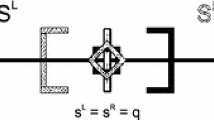Abstract.
The nature of the equilibria arising under spatial differentiation is investigated here in a duopoly model, where at least one firm maximises value added per worker. The study shows that if firms' objectives differ, there exists a subgame perfect equilibrium in pure strategies, which is possibly characterised by asymmetric locations. If both firms are labour-managed, there exists a (symmetric) subgame perfect equilibrium in pure strategies with firms located at the first and third quartiles, if and only if the setup cost is low enough. Otherwise, undercutting is profitable.
Similar content being viewed by others
Author information
Authors and Affiliations
Additional information
Received: 16 March 2000 / Accepted: 15 March 2001
Rights and permissions
About this article
Cite this article
Lambertini, L. Spatial competition with profit-maximising and labour-managed firms. Papers Reg Sci 80, 499–507 (2001). https://doi.org/10.1007/PL00013647
Issue Date:
DOI: https://doi.org/10.1007/PL00013647




